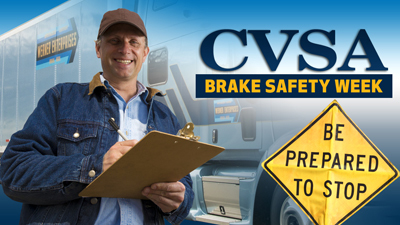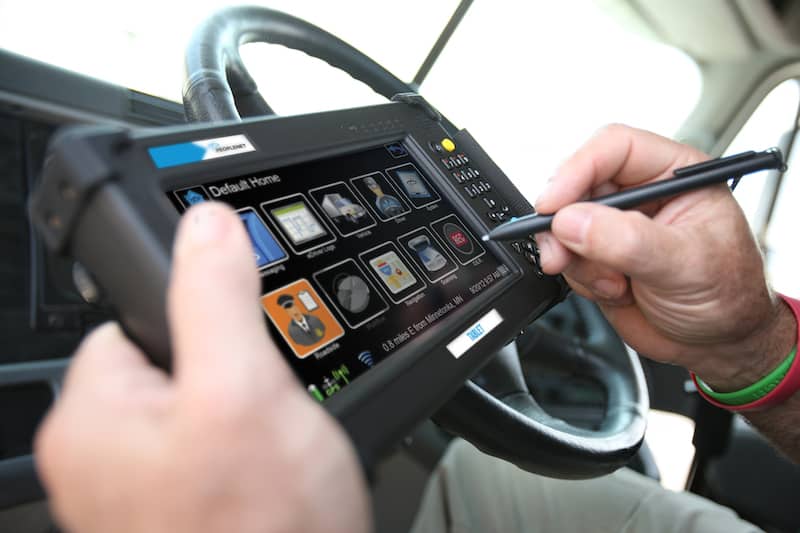The Commercial Vehicle Safety Alliance (CVSA) has scheduled this year’s Brake Safety Week for Aug. 20-26, focusing on brake lining/pad violations.
During Brake Safety Week, commercial motor vehicle inspectors highlight the importance of brake systems by conducting inspections of their components and removing commercial motor vehicles found to have brake-related out-of-service violations from our roadways until those violations are corrected.
Throughout Brake Safety Week, CVSA-certified inspectors will conduct their usual inspections; however, they will also report brake-related inspection and violation data to the Alliance. CVSA will compile that data and publish a press release this fall with the results.
“The focus of this year’s Brake Safety Week is on the condition of the brake lining and pad,” said CVSA President Maj. Chris Nordloh with the Texas Department of Public Safety. “Brake lining and pad issues may result in vehicle violations and could affect a motor carrier’s safety rating.”
When inspectors conduct the brake portion of a Level I or Level V Inspection, they will:
- Check for missing, non-functioning, loose or cracked parts.
- Check for contaminated, worn, cracked and missing linings or pads.
- Check for S-cam flip over.
- Listen for audible air leaks around brake components and lines.
- Check that slack adjusters are the same length (from center of S-cam to center of clevis pin) and the air chambers on each axle are the same size.
- Ensure the brake system maintains air pressure between 90-100 psi (620-690 kPa) and measure pushrod travel.
- Inspect for non-manufactured holes (e.g., rust holes, holes created by rubbing or friction, etc.) and broken springs in the spring brake housing section of the parking brake.
- Inspect required brake system warning devices, such as anti-lock braking system (ABS) malfunction lamp(s) and low air-pressure warning devices.
- Inspect the tractor protection system, including the bleedback system on the trailer.
- Ensure the breakaway system is operable on the trailer.
Brake safety awareness, education and outreach are major elements of the Brake Safety Week campaign. CVSA has outlined the brake-system inspection procedure (noted above) so that drivers and motor carriers know exactly what inspectors will be checking during roadside inspections. This transparency aims to remind drivers and motor carriers to take proactive steps to ensure their commercial motor vehicles are safe and compliant with Federal Motor Carrier Safety Regulations. Improperly installed or poorly maintained brake systems can reduce the braking capacity and stopping distance of trucks or buses, which poses a serious safety risk.
- Check CVSA’s vehicle inspection checklist for details on the brake portion of a Level I and Level V Inspection.
- Download our 2023 Brake Safety Week flyer for 10 tips on keeping your brake lining/pad healthy.
- View the inspection procedures.
- View previous brake-safety campaign results.
- Check the latest inspection bulletins. Currently, there are eight in the brakes category. Inspection bulletins provide important information to augment the existing inspection program.
CVSA’s Operation Airbrake Program is dedicated to improving commercial vehicle brake safety throughout North America. The goal is to reduce the number of highway crashes caused by faulty braking systems on commercial motor vehicles by conducting roadside inspections and educating drivers, mechanics, owner-operators, and others on the importance of proper brake inspection, maintenance, and operation.
FMCSA Reports to Congress on ELD Costs and Effectiveness
The Federal Motor Carrier Safety Administration has issued a report to Congress on the costs and effectiveness of the agency’s 2015 final rule on the use of electronic logging devices to record driver’s hours of service.
The report noted that the agency’s Regulatory Impact Analysis issued with the final rule estimated the total annualized industry costs to be $1.836 million, with annualized total benefits of $3.010 million, resulting in a net annual benefit of $1,174 million. The report concluded, “To date, FMCSA’s knowledge of ELD’s costs and benefits align with these estimates.”
As to the effectiveness of the ELD regulations, the agency pointed to a reduction in hours-of-service compliance violations since the final rule became effective in 2017. The FMCSA noted, “During the 2-year period from the compliance date, December 18, 2017, to the full compliance phase, which began December 17, 2019, compliance with the HOS categories [the 10/11-hour driving time limits for buses and trucks, respectively; the 14/15-hour driving window or on-duty limits for trucks and buses; and the 60/70-hour “weekly” on-duty limits] improved. In December 2017, 1.19 percent of driver inspections cited at least one HOS violation. In December 2021, that percentage decreased to approximately 0.77 percent.”
Yet although the report asserts, “Increased compliance with the HOS rules reduces the risks of fatigue-related crashes attributable, in whole or in part, to patterns of violations of the HOS rules,” the FMCSA failed to show any correlation between increased compliance with HOS requirements and improved safety performance due to reduced fatigued-related accidents, injuries or fatalities.
Although the report concluded the ELD rule made motor carriers more efficient in HOS compliance, and enforcement personnel more efficient in HOS enforcement, the FMCSA was unable to say that ELDs made the highways safer. The report noted that generally, “the anti-harassment provisions of the ELD rule, and ELDs themselves, improve safety and help prevent harassment of drivers by making it difficult for drivers and carriers to falsify drivers’ duty status, or force drivers to drive while fatigued or over hours, resulting in fewer violations of the HOS rules.”
Moreover, the FMCSA stated that “many drivers have anecdotally reported that the use of ELDs has prevented dispatchers from encouraging or forcing them to commit HOS violations, and drivers paid by the mile (the majority of over-the-road drivers) indicate that the improved documentation supported by ELDs helps reduce paycheck errors.”
But the report stopped short of concluding that use of ELDs had improved safety performance or reduced fatigue-related crashes, citing “multiple events [that] have occurred that have impacted the use of ELDs, safety, and HOS enforcement. Such factors include the September 2020 implementation of new HOS regulations, HOS exemptions issued in response to the COVID-19 pandemic (which suspended HOS rules for carriers transporting specified commodities in support of relief efforts during the pandemic), and the implementation of FMCSA’s Drug and Alcohol Clearinghouse.” The FMCSA said these factors have made it difficult to show any safety impacts of ELDs alone.
Analysis reveals the most dangerous times to drive
The highest number of road accident deaths occur on a Saturday (25,907 fatalities) and October (13,566 road accident fatalities) is the month with the most fatalities combined between 2016 and 2020.
The second most dangerous hour is from 8 p.m. to 9 p.m., during which time 8,387 fatalities occurred between 2016 and 2020, while 9 p.m. to 10 p.m. has the third highest total, with 8,241 deaths.
Weekends in general were a dangerous time to be on the road. There were 23,147 traffic deaths on Fridays, for the second highest total, and 23,038 on Sundays, high enough for third place.
July is the second deadliest month with 13,483 deaths, and September’s total of 13,404 is the third highest.
Looking at individual states, the most dangerous time in 13 states was 5 p.m. to 6 p.m., including in New York, Ohio, Massachusetts, Nevada, and Georgia.
In most states, the hour when the most road accident deaths occurred was generally between 3 p.m. and 10 p.m. However, in South Dakota the highest number of fatalities happened between 11 a.m. and 12 p.m., while in Maryland the most dangerous hour fell between 11 p.m. and 12 a.m., and in Rhode Island it was 12 a.m. to 1 a.m.









